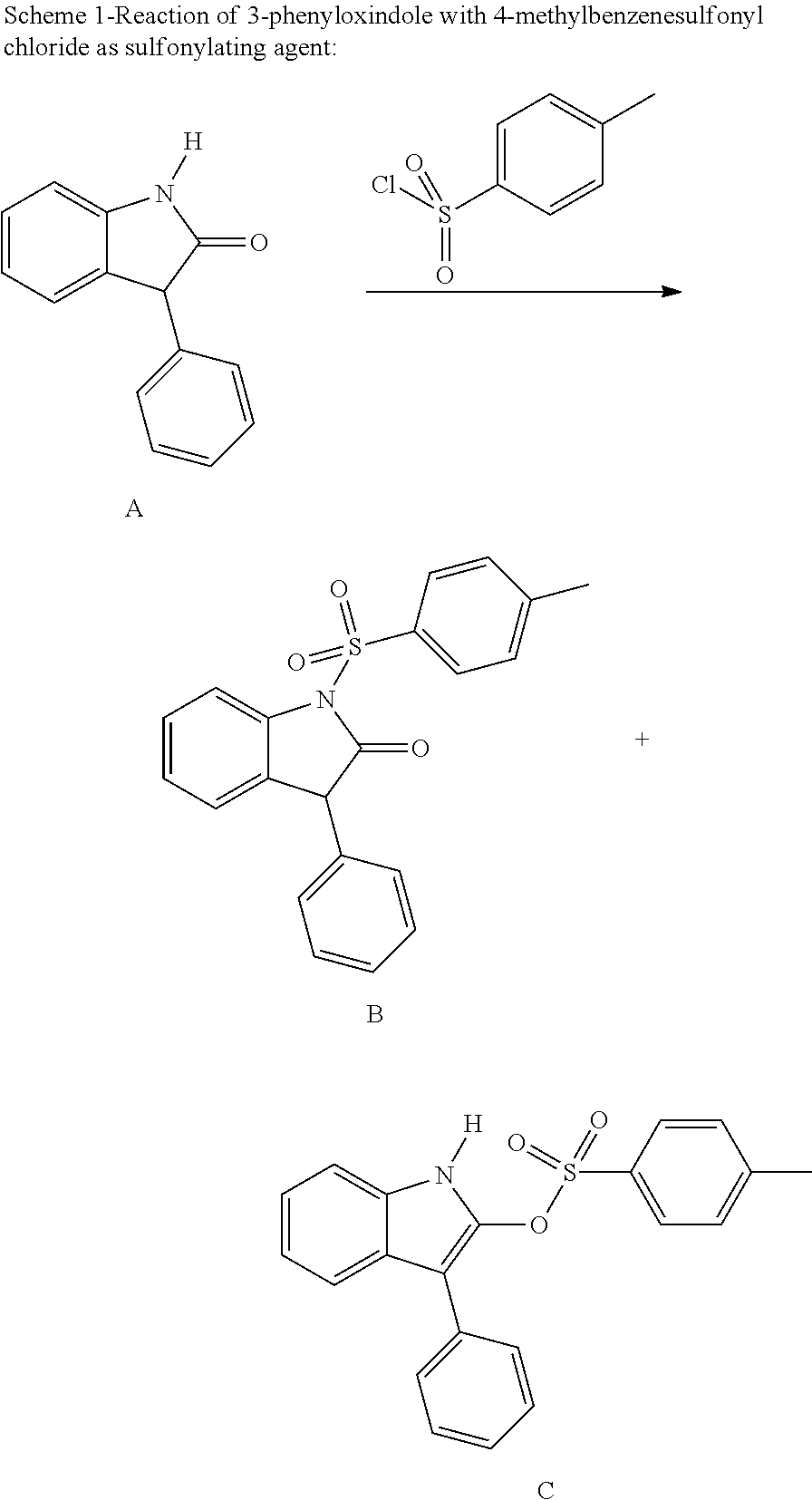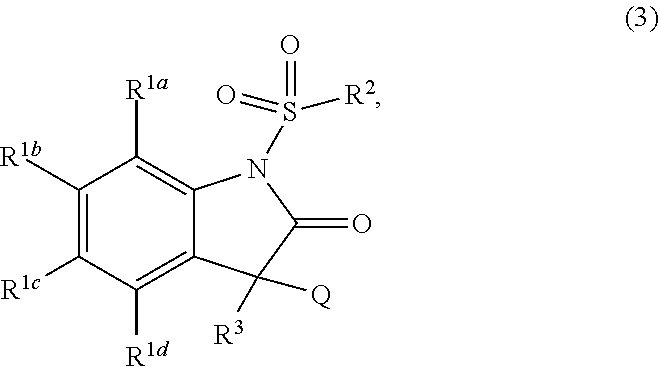Method for producing N-sulfonyl-substituted oxindoles
a technology of oxindoles and sulfonylsulfonyls, which is applied in the field of selective nsulfonylation of oxindoles, can solve the problems of not being suitable for industrial use, not being able to be recovered undecomposed, and not using the activating agent used in the process known to date, etc., to achieve the effect of suitable us
- Summary
- Abstract
- Description
- Claims
- Application Information
AI Technical Summary
Benefits of technology
Problems solved by technology
Method used
Image
Examples
example 1
Preparation of 1-[(difluoromethyl)sulfonyl]-3-(4,6-dimethoxy-1,3,5-triazin-2-yl)-7-fluoro-1,3-dihydro-2H-indol-2-one
[0280]
Variant A:
[0281]3-(4,6-Dimethoxy-1,3,5-triazin-2-yl)-7-fluoro-1,3-dihydro-2H-indol-2-one (95.7 g) and 1-methyl-1H-imidazole (53.1 g) are introduced as initial charge in 1120 ml of ethyl acetate and cooled to 0° C. under nitrogen. With vigorous stirring, difluoromethanesulfonyl chloride (73.7 g) is added dropwise at 0° C. to 5° C. over the course of 30 minutes and the mixture is after-stirred for 3.5 hours. Further difluoromethanesulfonyl chloride (4.9 g) is added to the reaction mixture, which is stirred for 1.5 hours. The reaction mixture is admixed with 500 ml of water and vigorously mixed. The organic solvent is largely distilled off in vacuo and the residue is filtered. The solid product is washed twice with in each case 250 ml of water, extracted from 400 ml of ethyl acetate / heptane (1:1) by stirring, filtered off and washed with 100 ml of ethyl acetate / hept...
example 2
Preparation of 1-[(difluoromethyl)sulfonyl]-7-fluoro-3-(4-methoxy-6-methyl-1,3,5-triazin-2-yl)-1,3-dihydro-2H-indol-2-one
[0290]
[0291]7-Fluoro-3-(4-methoxy-6-methyl-1,3,5-triazin-2-yl)-1,3-dihydro-2H-indol-2-one (1.20 g) and 1-methyl-1H-imidazole (0.97 g) are introduced as initial charge in 10 ml of dichloromethane and cooled to 0° C. under nitrogen. With stirring, difluoromethanesulfonyl chloride (1.21 g) is added in 2 portions and the mixture is warmed to room temperature. After 5 hours, 1-methyl-1H-imidazole (0.32 g) and difluoromethanesulfonyl chloride (0.61 g) are added and the mixture is stirred for 16 hours. After adding water and some hydrochloric acid, the solid is filtered off, washed with dichloromethane and water and dried. This gives the title compound as a solid in an HPLC purity of 91% (1.54 g, 92% of theory). The UV absorption (maximum at 360 nm) verifies the N-sulfonylation of the product.
[0292]LC-MS: M+H=389 (71%).
[0293]1H-NMR (400 MHz, DMSO-D6): δ (ppm)=7.94 (d, 1H...
example 3
Preparation of 1-[(difluoromethyl)sulfonyl]-3-(4,6-dimethoxy-1,3,5-triazin-2-yl)-1,3-dihydro-2H-indol-2-one
[0294]
[0295]3-(4,6-Dimethoxy-1,3,5-triazin-2-yl)-1,3-dihydro-2H-indol-2-one (10 g) and 1-methyl-1H-imidazole (5.4 g) are introduced as initial charge in 100 ml of dichloromethane and cooled to −5° C. under nitrogen. With stirring, difluoromethanesulfonyl chloride (7.03 g) is added dropwise at −5° C. to 0° C. over the course of 20 minutes, and the mixture is after-stirred at this temperature for 2.5 hours. The reaction mixture is admixed with 50 ml of water and mixed thoroughly. The organic solvent is largely distilled off in vacuo and the residue is filtered. The solid product is washed with water and acetonitrile and dried in a vacuum drying cabinet. This gives the title compound as a solid in an HPLC purity of 93% (12.5 g, 92% of theory). The UV absorption (maximum at 360 nm) verifies the N-sulfonylation of the product.
[0296]LC-MS: M+H=387 (98%).
[0297]1H-NMR (400 MHz, CDCl3):...
PUM
 Login to View More
Login to View More Abstract
Description
Claims
Application Information
 Login to View More
Login to View More - R&D Engineer
- R&D Manager
- IP Professional
- Industry Leading Data Capabilities
- Powerful AI technology
- Patent DNA Extraction
Browse by: Latest US Patents, China's latest patents, Technical Efficacy Thesaurus, Application Domain, Technology Topic, Popular Technical Reports.
© 2024 PatSnap. All rights reserved.Legal|Privacy policy|Modern Slavery Act Transparency Statement|Sitemap|About US| Contact US: help@patsnap.com










